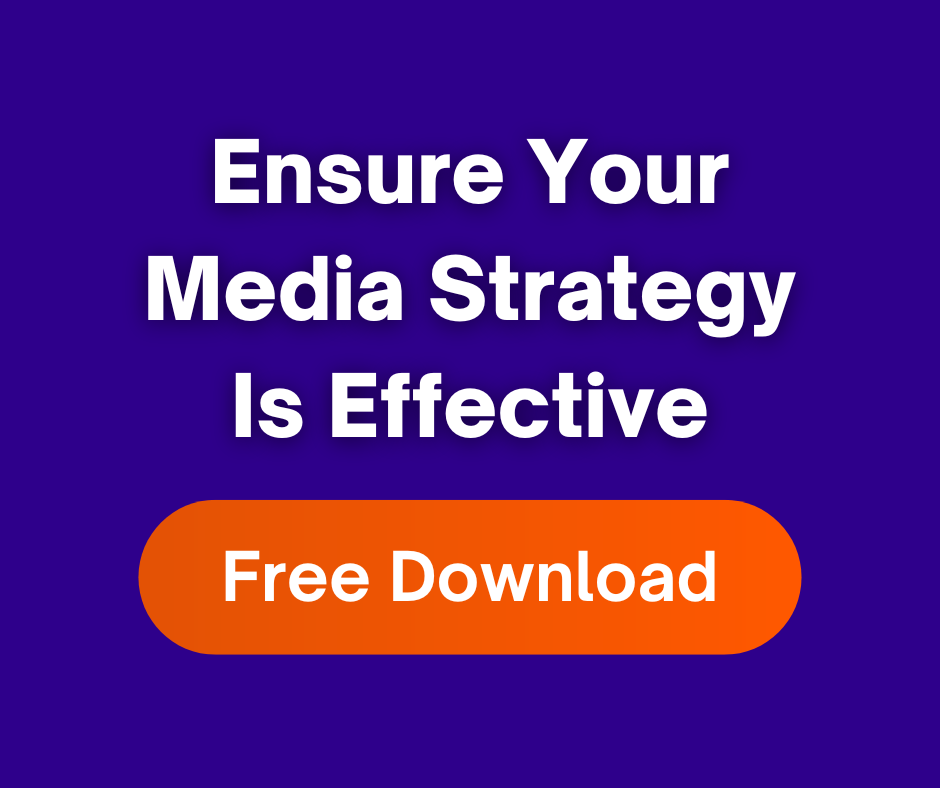While the phrase, “media buying,” seems straightforward, the ability to effectively master the media buying game in today’s diverse and crowded media landscape is a little more complicated than it seems.
Understanding Media Buying
Defining Media Buying: A Closer Look
What is media buying, you ask? Well, think of it as the art of strategically purchasing advertising space to get your message in front of the right audience at the right time. Paid media can be used to promote a message or drive traffic to gain sales or exposure for your brand. Purchased ads may appear on websites, radio, outdoor advertising, podcasts, social media, YouTube, television, and print media. Looking at how media buying has evolved can help demonstrate why it’s so complex today.
The Evolution of Media Buying
Media buying originated in the print media era with magazines and newspapers, where businesses directly negotiated deals with publications. With the introduction of radio, billboards, and television, media buyers needed to understand the benefits of all media channels and identify the best vehicles to reach potential customers.
In the digital age, search engines, websites, and social media were added to the growing advertising options. By 2016, advertisers sought transparency, efficiency, and improved performance, leading to more digital and traditional media inventory becoming available on Demand Side Platforms (DSPs). Media sellers have continually expanded the variety and volume of inventory on these platforms.
The Process of Media Buying
Step 1. Know Your Audience
First things first, you need to understand your target audience better than your own reflection in the mirror. Who are they? What do they like? Where do they hang out? And most importantly, what makes them tick? The better you know your audience, the easier it is to place your ads effectively.
Step 2. Set Your Advertising Objectives
Just like with any investment, you need clear goals. What are you looking to achieve with your media campaign? Are you after brand awareness, sales, or engagement? Once you’ve got your goals in place, it’s time to choose the right media.
Step 3. Choose Your Media Channels
There’s a whole smorgasbord of media channels out there – TV, radio, print, digital, social media, and more. Your choice of channel depends on your audience and goals. You might like TV for its reach, Radio for frequency of message, or digital media for its targeted impressions.
Step 4. Establish a Budget
It’s time to put your money where your mouth is. Set a budget that’s realistic – not too tight, but not too inflated either. You want enough firepower to get the job done without overextending yourself.
Step 5. Negotiate Like a Pro
Now it’s time to negotiate with the media vendors. You’re like a superhero in a bidding war, trying to get the best deal for your ad space. Be shrewd, be confident, and remember, you’re in the driver’s seat.
Step 6. Execute and Monitor Campaigns
Once your ads are out in the wild, it’s not time to sit back with a chimichanga. Monitor your campaigns like a hawk. Are they hitting the mark? Are you getting the bang for your buck? If not, be ready to make adjustments.
Step 7. Optimize and Adapt
Media buying is a dynamic game. If something isn’t working, don’t be afraid to change your strategy. Test different approaches, tweak your creative, and keep optimizing until you find the winning formula.
Step 8. Measure Results
After your campaign wraps, it’s time for the big showdown – measuring the results. Did you achieve your goals? What did you learn from this mission? These insights will help you level up for your next media buying adventure.
Please note that some of these same steps in Media Buying come from Media Planning (more on that subject in another blog post).
Media Buying Strategies
Remember, media buying isn’t just about throwing money at ads and hoping for the best. It’s about strategy, precision, and a good dose of creativity. Good media buyers will help you reach the right people with the right message at the right time. They’re like media superheroes, but instead of saving the world, they’re saving your brand’s reputation and bottom line.
Strategy 1: Determining the Right Media Mix
The term “media mix” is a combination of channels or methods brands can use to reach desired audiences. A media mix may be a combination of online and offline media channels.
Strategy 2: Choosing the Optimal Media Channels
A brand’s target audience will determine which media channels it should focus on. For example, a younger audience will most likely see a company’s ads on social media platforms like Instagram or TikTok, while an older demographic may spend more time on Facebook, YouTube, or the History Channel.
Strategy 3: Understanding Media Buying Metrics
Key performance indicators include reach, impressions, click-through rates (CTR), and conversions. All of these help businesses analyze the effectiveness of their media buying efforts to determine their Return on Investment (ROI) and Return On Ad Spend (ROAS).
Strategy 4: Utilizing Programmatic Advertising
With programmatic advertising, advertisers bid for ad space. Because of the built-in tools most programmatic advertising platforms offer, advertisers benefit from real-time insights and being able to quickly and easily make adjustments to ads.
Strategy 5: Leveraging Data and Using Analytics
A seasoned media buyer will leverage data to improve targeting and use analytics to find meaningful patterns in results data. Using techniques such as retargeting, you can deliver ads to people who have already interacted with your brand. The data during the campaign helps to inform optimizations.
Media Buying on Different Channels
Media Buying for Television
TV is known for its mass reach and immersive video ad format. Spots can be purchased to target viewers in local markets or nationally. Inventory can be purchased on both Linear (or Traditional TV such as broadcast television and cable television) or Connected TV.
Media Buying for Radio
Radio is used in audio strategies and is known as a frequency medium. Most local advertisers use radio for branding, promotional (sales) messages, and direct response offers.
Media Buying For Print
Print media is a contextual buy and part of your display strategy to target a desired audience via the appropriate newspaper, magazine, or other printed material. Ads can be purchased adjacent to desirable content.
Media Buying for Outdoor Advertising
Outdoor advertising is known for its ability to geo-target widely diverse audiences. It’s used as part of your display or video strategy. Make your outdoor creative impactful with imagery and low word count. Equally important, identify high-traffic locations.
Media Buying for Digital Platforms
Digital platforms are used to target audiences efficiently using display, audio, and video ads. Create engaging ads, and make sure they’re optimized for mobile screens.
Media Buying for Social Media
Social media ads are effective at micro-targeting specific fans or large groups of followers. The key is identifying which social media platforms your audience frequents. Platform-specific features like Stories or Reels on Facebook or Instagram can help maximize engagement.
Maximizing Effectiveness through Media Buying
Enhancing Reach and Frequency
Reach is how many people see your ad, and frequency is how often they see it. Having the right media mix will give your ad better reach, as will effective budgeting. For better reach, a budget should be spread out appropriately across the channels you’re using.
Optimizing Ad Placement and Timing
Placement refers to the spot on a page or screen where your ad appears. With print or digital ads, above-the-fold placement refers to the part of the page or screen that appears before the page is turned or the viewer scrolls down. Ad timing should align with the target audience’s media consumption habits.
Measuring and Analyzing Campaign Performance
Key performance indicators will help you evaluate the effectiveness of your campaign while it’s live and after it runs. Using tools like Google Analytics gives an understanding of your audience’s behavior and responses.
Benefits and Challenges of Media Buying
Benefits of Effective Media Buying
Effective media buying ensures ads are placed on the right channels within optimal content or at optimal times to reach a targeted audience to increase brand awareness. Partnered with effective messaging, it can drive customer acquisition and retention. You can enjoy an impressive return on investment (ROI).
Challenges and Pitfalls to Avoid
Media buying has its challenges and pitfalls. Failing to identify the correct target audience can result in wasted money and lost opportunities. When you choose the wrong media channels, your ads will reach an unreceptive audience, affecting your ROI. Learning how to monitor campaign performance is a steep learning curve, and a common mistake is to place ads and not monitor their performance.
The Future of Media Buying
Emerging Trends in Media Buying
The landscape of media buying evolves continuously, and new trends and innovations constantly reshape the industry. Expect to see programmatic media buying that leverages technology to automate the ad-buying process and maximize ROI. We’ll see more omnichannel approaches to reach a customer across all touchpoints, from digital and radio to social media and out-of-home. And personalization strategies that use data-driven insights for tailoring ads to an individual consumer’s preferences and behaviors will become more common.
The Influence of Artificial Intelligence (AI)
Artificial intelligence is a rapidly moving landscape. As new tools and capabilities are rolled out daily, it will impact media buying. Algorithms can analyze vast amounts of data to predict consumer behavior and aid in targeting and identifying trends faster. AI can make rapid and highly accurate audience-targeting decisions. Lastly, automation will continue to streamline the media buying process, from bidding and placement to tracking and optimization.
Media Strategy Checklist
Conclusion
Effective media buying drives brand awareness and increases consumer acquisition. While media buying isn’t new, the landscape changes rapidly and frequently. Staying on top of trends and best practices will give your ad campaigns the best possible chance of success.
Key Takeaways for Effective Media Buying
Here are the steps to successfully master media buying:
-
- Identifying target audiences
-
- Understanding clear objectives
-
- Knowing how to reach your audience
-
- Negotiating pricing and added value
-
- Continuously monitoring and optimizing ad campaigns
-
- Leveraging data and analytics to make advertising decisions
FAQs
What is the difference between media buying and media planning?
Media planning focuses on the strategy that will drive the media campaign. Planners figure out the best media channels to achive marketing goals. Media buying puts that plan into action. The media buyer will negotiate costs, manage the placement of media, and track performance.
How does programmatic advertising impact media buying?
By using data and algorithms, programmatic advertising allows advertisers to target specific audiences in real-time. Additionally, with programmatic advertising, you can more efficiently purchase ads that are precise and personalized. This might be manual buys, programmatic buys, or direct buys.
What are the essential skills for a successful media buyer?
Successful media buyers have strong analytical skills. These individuals are adept at analyzing data, understanding audience behavior, and making quick decisions. Negotiation skills are also important. To be a successful media buyer, it's essential to stay up-to-date on trends.




